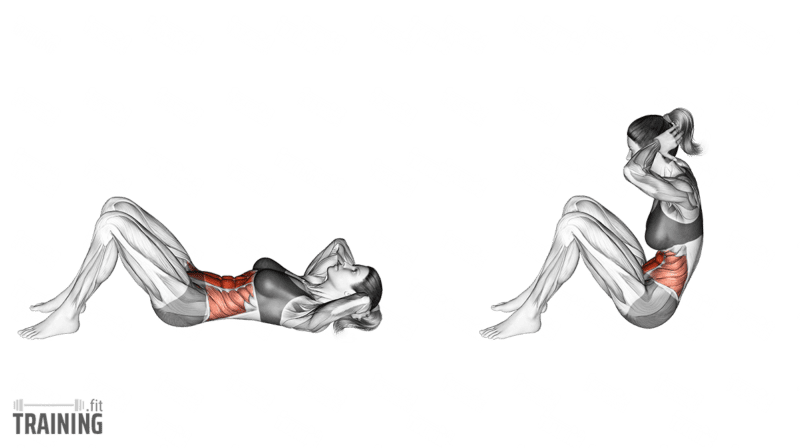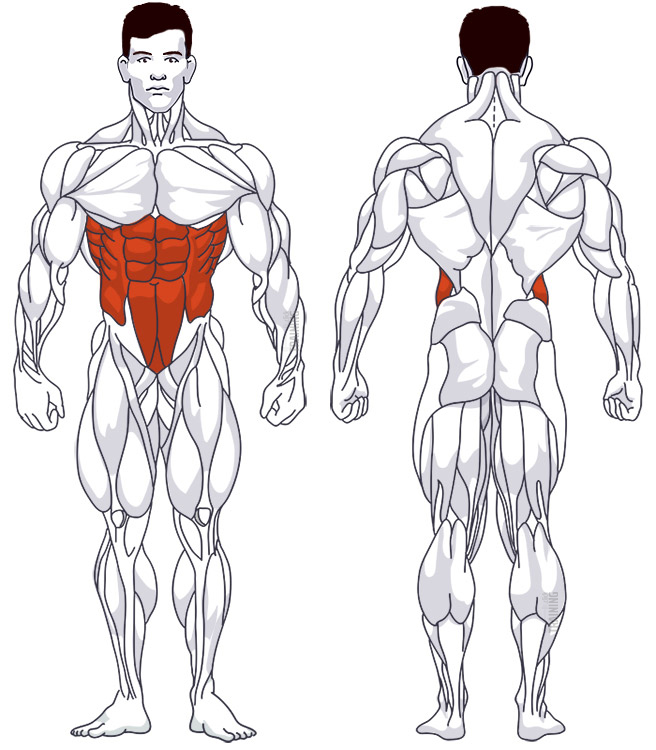Sit Ups
Isolation exercise, Body weightThis article is verified by 1 study/publication.
Overview

Main muscles
- Abdomen: Straight abdominal muscle
(Musculus rectus abdominis) - Abdomen: External oblique abdominal muscle
(Musculus obliquus externus abdominis)
Sit Ups: Basics and alternatives

Involved main muscle groups:
Sit Ups
One common mistake we’ve already mentioned is not giving your upper body enough space, which can cause your back to round slightly. This limits the range of motion and reduces the engagement of the targeted muscle groups. If you don’t have enough room and still try to pull your elbow up to shoulder height, your neck will work harder than your latissimus dorsi. So, choose a spot that allows you to position your body optimally on the bench.
We all know and have probably done Sit Ups at some point. This classic ab workout involves lying on your back with bent legs and lifting your entire upper body towards your knees, isolating the rectus abdominis muscles.
Sit Ups are often confused with Crunches due to their similar appearance. However, crunches have a smaller range of motion, focusing more on the upper area of the abs.
As an alternative to regular Sit Ups, you can perform the exercise on a decline bench. Like crunches, this variation focuses more on the upper area of the rectus abdominis, but with a larger range of motion as the upper body bends backward, covering more distance to complete the movement.
Correct Execution
There are many small variations when performing Sit Ups, especially regarding hand placement. You can place your hands in front of your chest, beside your body, or beside/behind your head. Wherever you place your hands, make sure not to use them for momentum or to apply force to your upper body. If your hands are on your head, keep them loose and use them only for stabilization.
Moving your hands forward makes the Sit Up easier, as it shifts the center of gravity. Placing your hands next to your hips is a good option for beginners. Advanced exercisers can extend their arms straight overhead to increase training intensity.
In Sit Ups, your knees are bent, but as a beginner, you may need to anchor your feet. As you advance, you’ll be able to keep your feet wedged with bent knees. Extending your legs shifts the center of gravity forward, making the exercise easier.
Some Sit Up variations involve lifting your bent legs. Depending on your arm position, this can result in stronger muscle activation than with legs on the ground, as a 2010 publication shows [1].
It’s important to choose a variation and focus on executing it correctly within a set. As you progress, you can try different Sit Up variations and increase the intensity.
Video tutorial
Step-by-step instructions
Lie down on a workout mat.
Bend your knees to a 90-degree angle, with your heels and toes touching the ground, if possible. Keep your legs close together and no wider than hip-width apart. Anchor your feet if necessary.
Place your hands on the sides of your head, lightly touching your head with your fingertips. Lie flat on your back, looking up. You’re now in the starting position.
Control your upper body by bending at the hips, moving your head towards your knees. When your upper body or abdomen touches your legs, the movement is complete. Return to the starting position in a controlled manner. To make the workout more effective, maintain tension in your abdominal muscles, even in the starting position, and don’t relax on your back.
Common mistakes and injuries
Avoid swinging during sit-ups, as it’s a common mistake that reduces the effectiveness of the exercise. Though sit-ups can be challenging for beginners, it’s crucial to lift your upper body in a controlled manner. Fewer controlled repetitions will provide greater muscle stimulus.
Don’t pull your head up when your hands are crossed behind it, as this can also lead to a swinging movement and increase the risk of injury due to excessive neck stretching. Be cautious with this hand placement and keep your arms loose on the sides/behind your head. Alternatively, you can place your hands in front of your chest or on your hips, but keep them loose here as well.
For traditional sit-ups, keep your feet on the ground throughout the exercise. Don’t lift your feet just because the repetition is difficult. Only lift your legs if you’re intentionally performing sit-ups with bent legs in the air to change the training stimulus.
Sources
- Electromyographic Muscle Activity in Curl-Up Exercises With Different Positions of Upper and Lower Extremities. Rutkowska-Kucharska, Alicja; Szpala, Agnieszka. Journal of Strength and Conditioning Research. November 2010 – Volume 24 – Issue 11 – p 3133-3139. doi: 10.1519/JSC.0b013e3181ddb308, accessed on 02.09.2021